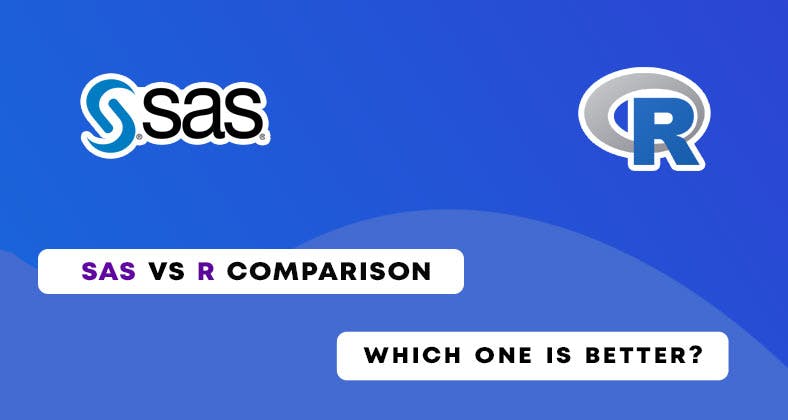SAS vs R | Fully explained
SAS vs R has ever been the biggest clash in the analytics business we know. Here we are going to give a short description of these two Ecosystems and a comparison between them.

Introduction
SAS
SAS is one of the unchallenged market principles in the commercial analytics field. This program is having an enormous diversity of statistical functions that comes with a greater GUI for individuals to learn fast and provides magnificent technical support. Still, it finishes as being the expensive alternative.
R
R is an open-source software equivalent to SAS. It has been applied in the research center and the professors. The latest version of R was published recently just because of its open-source nature. There is so much documentation accessible over the internet but they are very costly alternatives.
History
SAS
SAS language is created at North Carolina State University by Anthony J Barr from 1966 to 1976. It was coded in the C programming language and begins its journey as a project to examine the agricultural data and increase crop yield. SAS was released day after day in 1972 before releasing the 9.3 version.
R
R is developed by Ross lhaka and Robert Gentleman to implement the S programing language. At first, it was called after the first name of the two authors. It was written in the C language, Fortran, and R. Its initial version was released in 1995 and stable data version in 2000.
SAS vs R
Cost
SAS is proprietary software. So the company needs to pay a considerable amount to use it. Still, beyond SAS extend for the majority of the companies in its individual performance. Despite being costly, it holds a big amount of the market share in an individual institution. SAS also has a free University edition.
Oppositely, R is open-source software. So, anyone can download and use it for free.
Speed
SAS authorizes stronger data analysis using SAS SQL and automatic code generation with reusable code fragments. So it is quicker to develop and its backend is also is quite fast.
Being a low-level programming language R is not as faster as SAS. So you need more extended codes for a simple way, which results in lower speed.
Easy of learning
SAS has a simple GUI which is why it is easier to learn than R. So anyone can pick it up without a preceding programming language. That’s why people pay for it for its easily manageable abilities.
R has a steep learning loop just because it is a low-level language. So if you want to learn R you have to have a working experience of programming.
Data Handling
No matter where is your data is stored SAS can perform well-organized data handling and manipulation using the data step which assists the compilers to run faster and helps you to access the data you need.
On the other hand, R has a disadvantage as it works only on RAM which is why small tasks take more time to run. But data manipulation is easier with packages like plyr, dplyr, and tidyr.
Data visualization and Graphical analysis
In data visualization and graphical analysis, SAS is a little bit slow and compound. SAS is still trying to improve its visualization and graphical potential but is yet to match the quality of R.
Here R has the best visualization and Graphical analysis for the packages like ggplot, lattice, ggvis, rgis, etc. So R can so quickly pump the result out and put it into a graph.
Deep learning
R comes with the packages like KerasR that behave as an interface to the originals python packages Keras. It has also other packages like MXNetR, H2O for Deep Learning. H2O is one of the best packages for Deep Learning.
SAS is a couple of steps behind R in deep learning. SAS is still working to improve its deep learning support with open source packages like DLPy, Caffe models, and set up its own Deep Learning tools.
Uses in Industry
SAS has a vast application in the pharmaceutical industry for creating medicines, analyzing patient records, and clinical research. It is widely used in Business Intelligence and weather forecasting.
R is used in every field like finance, BioScience, Manufacturing, and supply chain. R is positively used for statistical analysis, data visualization, machine learning.
Customer & Community Support
Being free, _R (opens in a new tab)* does not have any customer support. But it has large online community support to solve any issues.
SAS (opens in a new tab) has great customer support because it’s paid software. It has 24×7 customer service to help you as well as an online community to assist solve your queries.
Job opportunities
As we know SAS is costly. So it is completely used in the big organizations who can effort the cost of buying the SAS software. Therefore, there are fewer numbers of jobs in SAS.
R developers have a huge demand in the field of statics and analysis. Every company is looking for developers who can pick up their data efficiently.
Related: What is Metaverse Explained (opens in a new tab)
Conclusion
This was a detailed article on ‘SAS vs R’, I’ve explained what are the use cases and other necessary factors. Unquestionably, there is no aim in this race. It is just a comparison between two programming languages and we just wanted to show you the pros and cons. Set on your condition you can add load and turn up with what might be applicable for you.
- If you are going to have a startup then R is not so much useless.
- If you are beginer going in for the analytics field, it is highly recomended to learn the basic of Data Science with R as your first language.
- If you have spent lot of time in business then your experties should learn a brans new tool.
